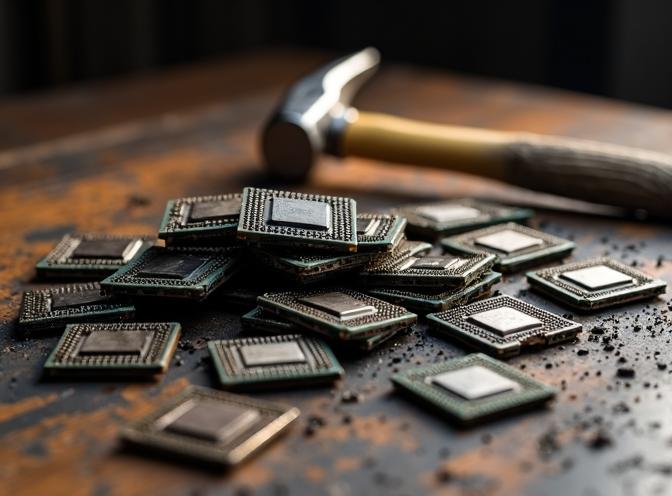Degradation Issues in Intel's 13th and 14th Generation CPUs
And why have I been seeing this BSOD...
I was hit hard by this issue. But you should investigate and test your PC if your BSOD is like mine. The cause was Intel’s CPU Degradation Issue in 13th and 14th generation.

Disclaimer: The following research report is provided for informational purposes only and does not constitute professional technical advice. Readers are encouraged to consult certified professionals or official sources for detailed guidance on hardware issues.
Background
Over recent months, discussions on tech forums and articles (e.g., from Windows Central, The Verge, and Tom’s Hardware) have revealed that a specific microcode bug in Intel’s processors is responsible for issuing excessive voltage requests. This issue particularly affects:
- Desktop Processors: Especially models operating at higher wattages (>65W), where the over-voltage stresses internal components such as clock tree circuits.
- Certain Laptop Models: Although less consistently reported, similar issues have been observed in some low-power variants like T-series and W-series CPUs.
The core problem lies in a firmware-level error that leads to an improper regulation of power delivery during idle or light-load conditions. Once the excessive voltage is applied repeatedly over time, it may result in irreversible damage to critical internal circuits.
Cause of the Issue
- Microcode Bug: The primary cause is identified as a firmware/microcode bug that triggers over-voltage conditions during certain operational states.
- Impact on Hardware: Repeated exposure to excessive voltage can stress and eventually damage internal components, particularly affecting the clock tree circuits.
Observable Manifestations
- Instability Symptoms: Unexpected shutdowns, blue screens (BSODs), crashes, and performance degradation.
- User Reports: Many users have noted that even temporary fixes (e.g., disabling Turbo Boost) do not resolve underlying issuesâthese are symptomatic rather than curative.
Mitigation Measures
-
BIOS Updates:
- Firmware Incorporation: Users should apply BIOS updates that include microcode update version 0x129. This update is designed to limit the CPUâs voltage request to a safe threshold.
- Pre-built Systems: Many pre-built machines will receive this update via Windows Update or manufacturer-specific tools (e.g., Lenovo Vantage, Dell SupportAssist).
- Custom Builds: Users with custom systems should manually download and install the latest BIOS from their motherboard vendorâs website.
-
Power Profile Adjustments:
- Avoid using Extreme power profiles if they override undervolt settings. Switching to Baseline or Performance profiles can help maintain better voltage regulation and temperature control.
-
Precautionary Measures:
- Always back up critical data before performing firmware updates.
- Monitor system stability after updating; persistent issues may require further diagnostics or replacement under extended warranty provisions (Intel has extended warranties for affected CPUs by two years).
Insights:
- Preventative vs. Curative Measures: The firmware and BIOS updates primarily serve as preventative measures for CPUs that have not yet sustained irreversible damage. Once significant degradation has occurred, these updates do little to repair the affected hardware.
- User Experience Variability: Although many users report similar symptoms across different platforms, variations exist based on processor variants (desktop vs. laptop) and power configurations.
- Industry Response: Intel’s proactive steps through multiple microcode revisions and support extensions demonstrate an awareness of the issue and a commitment to mitigating further damage.
Conclusion
The analysis confirms that voltage-related degradation in certain Intel 13th and 14th Generation CPUs is primarily due to a firmware/microcode bug leading to over-voltage conditions. The updates (0x125, 0x129, and the forthcoming 0x12b) along with BIOS adjustments are crucial for preventing additional damage but do not restore already compromised hardware.
- Update Regularly: Users should ensure that both their systemâs firmware and BIOS are updated to the latest versions provided by Intel and their motherboard manufacturers.
- Maintain Default Settings: Keeping power settings at default Intel recommendations can help reduce the risk of over-voltage conditions.
- Monitor System Health: If instability or performance degradation is observed, users should promptly contact technical support for potential warranty claims or necessary replacements.
- Stay Informed: Given that new updates may be released as further analysis occurs, it is advisable to monitor official channels for any additional recommendations or notices.
When I was trying to submit request to intel’s warranty - there no luck, but was some website bug - “spinning wheel”, probably timeouts because of website overload of such requests?

